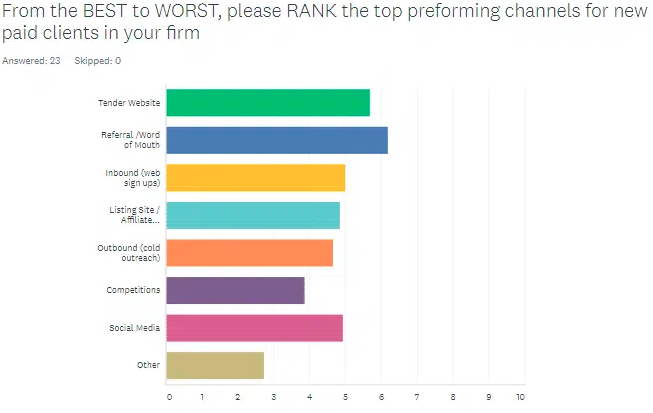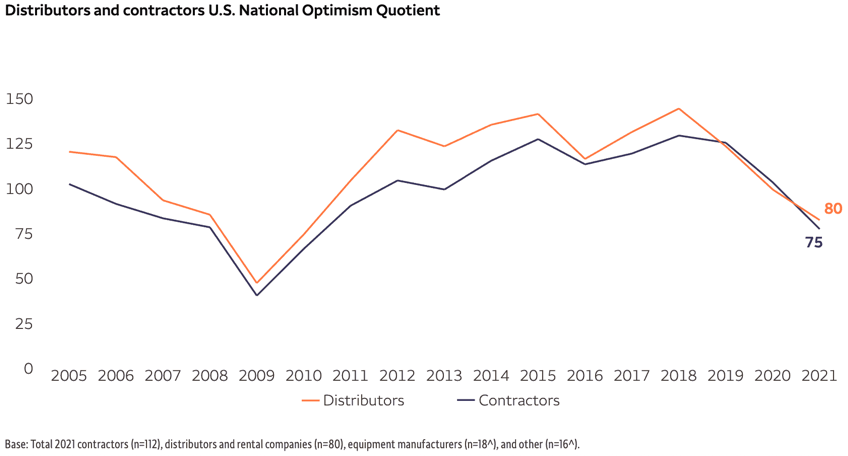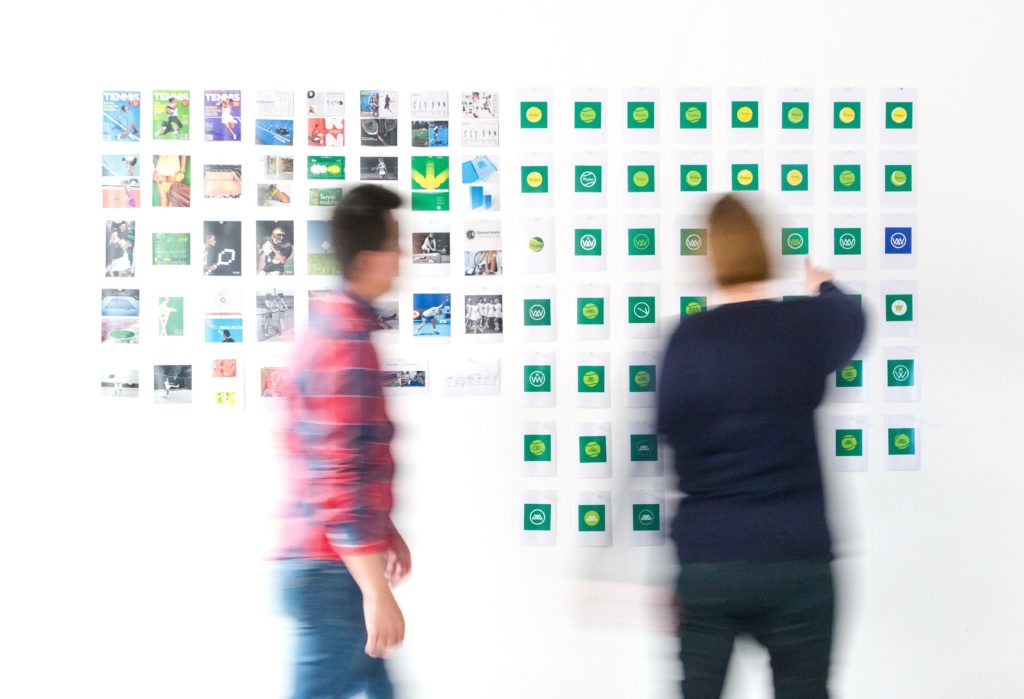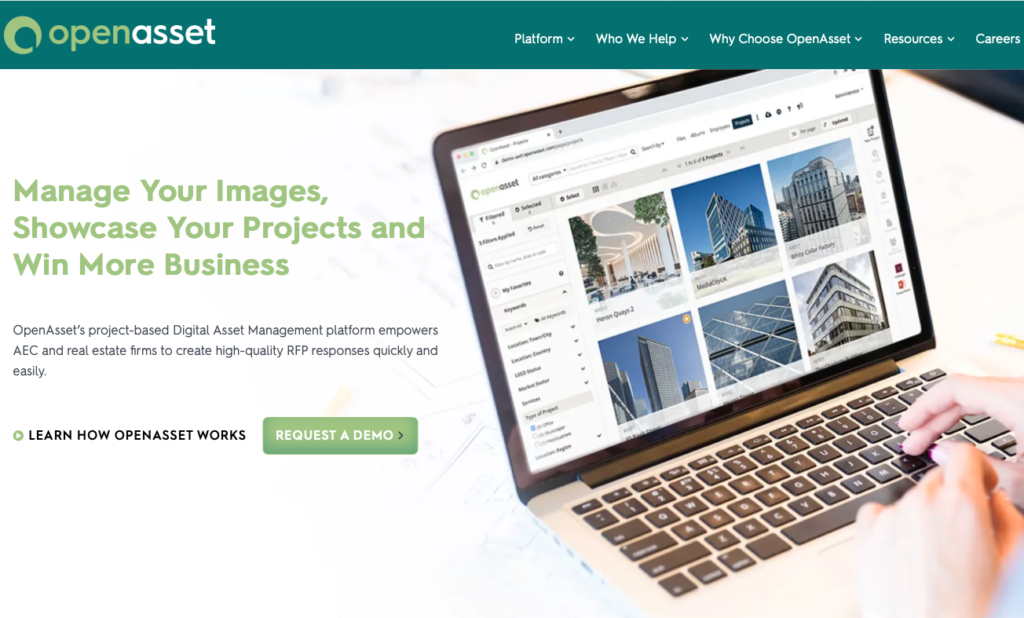Winning Strategies and Key Technologies to Help Your Firm Improve Productivity and Create Better RFP Responses Faster
OpenAsset partnered with the CE Strong webinar series and The Architect’s Newspaper to learn what architecture firms are doing in 2022 to overcome proposal development challenges.
This article details what we learned from the webinar, including proposal management strategies and the key technologies that firms can implement this year to improve productivity, and create better RFP responses. Featured experts include:
- Cindi Michelsen, Marketing Manager for RDG Planning & Design,
- Rachelle Ray, Founder of RMR Consulting, and
- Russ Sanford, Senior Vice President at Kleinschmidt.
Winning Strategies for Architecture Proposals
According to our panel of AEC industry experts, the best way to approach architecture proposals is to break the entire RFP process down into four parts:
- Pre-RFP intelligence – The process of collecting information from industry experts, analysts and prior relationships related to upcoming RFPs, contracts and potential projects.
- Go/No Go Determination – The Process by which a firm determines whether or not to pursue an RFP.
- RFP Response and/or Proposal Creation – The process of responding to the RFP and/or drafting, editing and submitting a winning proposal.
- Post Proposal Debrief – The process of determining what parts of your proposal strategy were effective and which parts were not.
By doing so, you enable your team to delegate, manage and examine each part of your proposal writing process for maximum efficiency and effectiveness. The more you improve upon the parts of that process, the better your proposal will be. Therefore, according to our experts, the first thing you should do to improve your proposal strategy is to create a proposal management plan.
Create a Proposal Management Plan and Outline Your Win Themes
“I think the most important thing is to find the process that works best for your team.” Says Rachelle Ray, Founder of RMR Consulting, and creator of a flexible proposal management process that uses strategic messaging and storytelling techniques to develop winning proposals.
“For my clients, we have a proposal management plan for almost every single [proposal] we do” Says Ray. “Everyone who is responsible for something – their name goes in this document alongside their responsibility and when it’s due. Then the [proposal management plan] get’s recirculated to everybody after the kickoff meeting. So, everybody’s always on the same page.”
According to Ray, the next step in the process is to outline your win themes. “That way we don’t get to the final draft and somebody notices that we need to be talking about this super important thing for the client that we knew about, but didn’t download to the team.”
Use Pre-RFP Intelligence to Create a Win Strategy
According to Russ Sanford, Senior Vice President at Kleinschmidt, and Certified Professional Services Marketer at the Society for Marketing Professional Services (SMPS), gathering that type of pre-RFP intelligence is the biggest challenge facing the industry.
“Pre-RFP intelligence is the biggest challenge they have.” Says Sandford, regarding AEC firms. “The reason we have that is because we’re engineers and architects. We’re not taught in school how to do business development. We bypass that whole process.”

Sanford’s insight corroborates a recent poll of 23 Danish architecture firms, who said “tender websites” and “word of mouth” were their top-performing channels for paid clients. In other words, the data shows that AEC firms struggle with business development because they lack the foundation they need to seek out new opportunities.
“We may do marketing in our firm,” Says Sanford. “We do a lot of proposals, but we don’t have a business development process where we go out and learn who our clients are… their needs… their issues… their pain points… We can bring that back to the proposal team and put together a win strategy.”
According Cindy Michelsen, marketing manager for RDG Planning and Design, you should make that information readily available. “Win themes. Issues. Features. Benefits. Proof. Those sorts of things – write that at the top of the cover letter and build everything around that. Whatever that win theme or story is should become the guiding principle of the proposal.”
Michelsen’s insight is in line with AEC proposal writing best practice, which states that every proposal should contain a high-level overview of the project’s objective, its essential qualities and the reasons why your firm would like to undertake the project.
Establish a Go/No Go Process (Make it a Conversation)
“I think this also leads very well into the next step, which is the go/no go process. I know it is a contentious point among a lot of firms on whether you have one, what it looks like, and how extensive it is,” says Michelsen, “but I think this pre-RFP planning and intel gathering is super important to the go/no go or bid no bid.”
Michelsen goes on to explain the go/no go process at her firm. “We have several go/no go sheets that we use as a checklist for different markets… It’s not one size fits all. They are customized per studio or client type to help people hone in on the right things… We probably have four or five different ones that we use on a regular basis. And I encourage people that it’s not just to use it when you can’t make a decision, you should be using them on all your proposals.”
“I would agree with that 100%…” says Sanford. “We have a go/no go discussion on every competitive pursuit.” According to Sanford, the keyword is discussion. “It’s a conversation about can we win this, not can we do the work. We could probably do anything, anywhere, anytime. But can we win it?” Do we have enough intelligence about what the client’s looking for? Do we understand who the competitors are? Maybe there’s an incumbent. Do we understand those pieces of it?”
Use the Go/No Go Process to Make Your Business More Efficient
“Look at it as an opportunity cost.” Says Sanford, “We had very high proposal expenses. So we started clamping down on the go/no go process. In the last three years we went from pursuing 125 competitive pursuits to 75. But we’ve been able to increase our capture rate – how much money we win per proposal – from 20% to over 51%.”
Sanford’s insight corroborates the results of a Wells Fargo 2021 Construction Industry Forecast, and survey conducted by OpenAsset that reveals 58% of proposal professionals in the AEC industry feel overworked. A more selective and precise go/no-go process could significantly relieve the burden on proposal teams.

“Most firms are overwhelmed with work and don’t have enough talent to be able to do all that work.” Say Sanford. “So, this is a great opportunity to really refine these processes and focus on the most fruitful clients.”
Focus on Winning More Work Instead of Submitting More Proposals
“Right.” Says Michelsen, “Our objective is to win more work, not more proposals.” Yet, according to Michelsen, it’s far too easy for firms to fall into unproductive processes that lead them away from a winning strategy.
“It’s easy to get sucked into the funnel of doing proposals, and just do the next one, and the next one, and the next one, without questioning if it’s the right [proposal] to be doing. Does it fit a strategy plan that you have for growing?” If not, Michelson argues “it’s helpful to reframe things.”
Debrief Team After Proposal Win/Losses To Improve RFP Intelligence
According to our panel of experts, the same process of RFP intelligence gathering should be applied to past proposals, especially the proposals that were unsuccessful. “As far as a process, if you’re using the intelligence or debriefing on proposal losses, then you should absolutely inform the team so you can use that during the go/no go conversation.” Says Sanford.
“Yeah,” Says Ray, “I think debriefing your proposals to find out what you did well, and what you didn’t, that definitely should influence your go/no go decision because that all goes back into the RFP intelligence cycle.”
“The biggest thing to me, when I think about a go/no go,” Says Sanford, “is did we know the client? And did we know the RFP was coming? If we don’t know the client, and we don’t know when the RFP was coming out… then why do you think you have an opportunity to win this?”
According to Michelsen, the most important part of the post-proposal debrief is determining the pain points of the proposal creation process. “We try to debrief with the team that put it together before we ever know if we won or lost just to see what the pain points were – what we should have done differently, so we don’t hit that roadblock again the next time.”
Identify Win Themes to Differentiate your Firm and Avoid Assumptions
Equally important to the go/no go process and the post-proposal debrief, says Sanford, is identifying the themes that differentiate your firm from the competition. “Our clients can’t differentiate one firm from another. All they do is they look at the bottom line. So to me, the biggest issue in the proposal process starts with how we train people to get out there and understand that.”
In other words, to improve your chances of writing a winning proposal, you need to not only identify your client’s needs, but also the features that differentiate your firm from the competition. “Whatever that win theme or story is becomes the guiding principle [of your proposal].” Says Michelsen.

Different industries may refer to your win theme in different ways, but according to Ray, “win themes are the guiding strategy and the backbone of your proposal… They take the client’s pain point, the challenge, their issue, and combine that with your firm’s features, or attributes and how you’re going to solve that challenge.”
As for how you determine your win themes, Sanford says they are determined by client needs. “That’s where client intelligence comes in. If you don’t have that, then you have to make assumptions solely on your differentiators – where you can add value, and what other clients have said, how you add value to their projects.”
According to Michelsen, that’s where the front end work really pays off. “Sometimes, once the RFP comes out, you can’t talk to that client again. So, if you’ve been talking to them ahead of time, and you get a feel for what they are looking for, then you’re ahead of the game when you get the RFP.”
“Ultimately,” says Sanford, “It doesn’t matter what size of firm you have, you need to have a strategy behind what you’re pursuing and what you’re trying to accomplish.”
Allocate Resources to Proposals and Collaborate With Technical Staff
Though establishing a go/no go process and your win theme is important, our panel of experts believe that all of it is useless without the resources to create a winning proposal. “If you don’t have the resources to put together a proposal, it doesn’t really matter how much you want it.” Says Ray.
According to Ray, those resources include technical staff. “A signature part of me as a consultant is meeting my technical staff where they are as much as possible. So, understanding that they’re probably working on billable projects and marketing is maybe not top of their list.
So I do my best to never send them a blank document and say, ‘will you start filling in your approach, or will you start telling me about this project?’ I will start filling stuff out for them. I’ll brainstorm. I’ll give them a call and start taking notes, then type it up and ask them to verify.
It also helps me to better understand the content that we’re putting together because I am not an engineer or an architect by education.” Says Ray. “So it helps me with learning as well, which also leads to my team appreciating my efforts more. So maybe not what all of the marketers want to hear, more effort on our end, but it pays off I promise.”
Implement DAM Technology To Write Better Proposals
When it comes to writing better proposals, there is a consensus among our experts – digital asset management tools make the process easier, and more productive. “We have OpenAsset that we use for images, and marketing globally,” says Sanford, “not just for proposals, but that’s because we’re spread out all over.”

“Yeah.” says Michelsen, “We just recently invested in OpenAsset for our images, which has really helped us utilize some of that data we have scrolled away in Deltek, which we were just copying and pasting… we’ve only just scratched the surface on that.”
Stay Tuned for More Expert Insight and Webinar Content from OpenAsset
The expert insight provided in this webinar corroborates the results of a Construction Industry Survey conducted by OpenAsset, which found that 89% of respondents believe DAM solution would increase the overall efficiency of their staff and reduce their level of stress.
Fortunately, digital asset management is now top of mind for AEC industry executives looking to grow their firm and secure new business opportunities in 2022. Moreover, digital technologies like OpenAsset are now considered essential to the promotion of AEC brands.
Why? Because, unlike traditional systems, OpenAsset is designed exclusively for the AEC firms that build our world and shape our society. With seamless functionality, a user-focused experience and project-based workflows, OpenAsset is the only DAM with the power to automate your marketing efforts, improve brand consistency, optimize the proposal writing process and enable your team to do their best work.
Follow the link for more insights on the AEC industry or to schedule a demo of OpenAsset with one of our solution experts. Don’t forget to follow OpenAsset on social media for exclusive offers and valuable insight for AEC and Real Estate firms.



